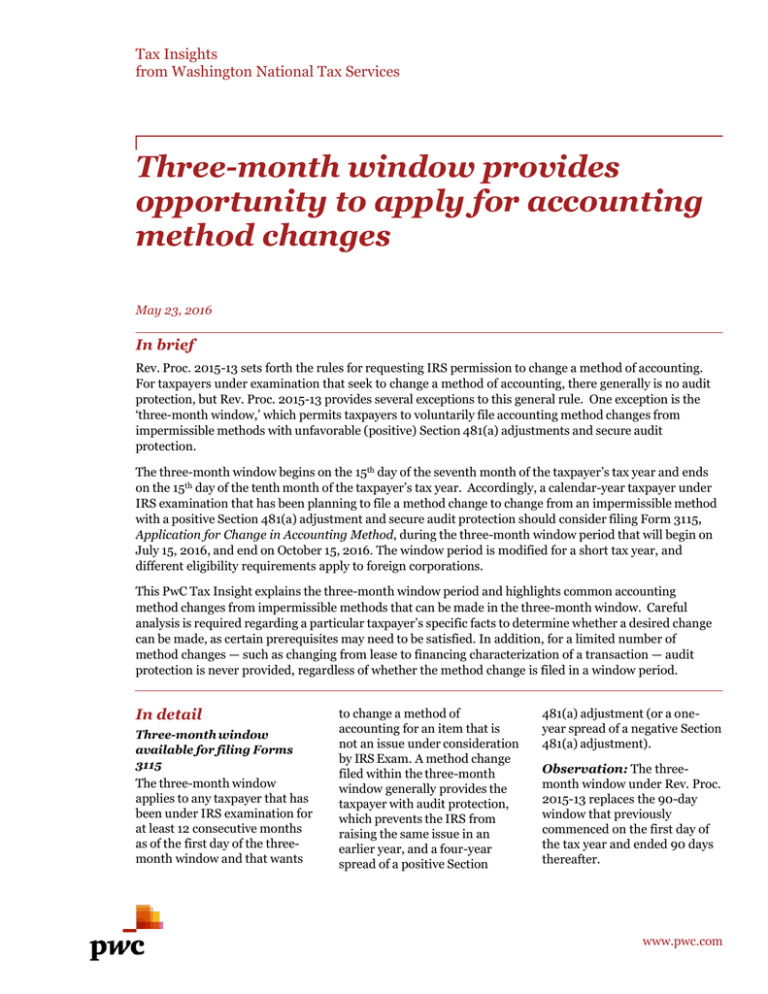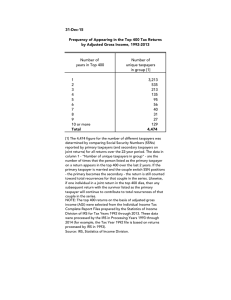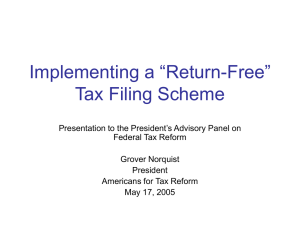
Tax Insights
from Washington National Tax Services
Three-month window provides
opportunity to apply for accounting
method changes
May 23, 2016
In brief
Rev. Proc. 2015-13 sets forth the rules for requesting IRS permission to change a method of accounting.
For taxpayers under examination that seek to change a method of accounting, there generally is no audit
protection, but Rev. Proc. 2015-13 provides several exceptions to this general rule. One exception is the
‘three-month window,’ which permits taxpayers to voluntarily file accounting method changes from
impermissible methods with unfavorable (positive) Section 481(a) adjustments and secure audit
protection.
The three-month window begins on the 15th day of the seventh month of the taxpayer’s tax year and ends
on the 15th day of the tenth month of the taxpayer’s tax year. Accordingly, a calendar-year taxpayer under
IRS examination that has been planning to file a method change to change from an impermissible method
with a positive Section 481(a) adjustment and secure audit protection should consider filing Form 3115,
Application for Change in Accounting Method, during the three-month window period that will begin on
July 15, 2016, and end on October 15, 2016. The window period is modified for a short tax year, and
different eligibility requirements apply to foreign corporations.
This PwC Tax Insight explains the three-month window period and highlights common accounting
method changes from impermissible methods that can be made in the three-month window. Careful
analysis is required regarding a particular taxpayer’s specific facts to determine whether a desired change
can be made, as certain prerequisites may need to be satisfied. In addition, for a limited number of
method changes — such as changing from lease to financing characterization of a transaction — audit
protection is never provided, regardless of whether the method change is filed in a window period.
In detail
Three-month window
available for filing Forms
3115
The three-month window
applies to any taxpayer that has
been under IRS examination for
at least 12 consecutive months
as of the first day of the threemonth window and that wants
to change a method of
accounting for an item that is
not an issue under consideration
by IRS Exam. A method change
filed within the three-month
window generally provides the
taxpayer with audit protection,
which prevents the IRS from
raising the same issue in an
earlier year, and a four-year
spread of a positive Section
481(a) adjustment (or a oneyear spread of a negative Section
481(a) adjustment).
Observation: The threemonth window under Rev. Proc.
2015-13 replaces the 90-day
window that previously
commenced on the first day of
the tax year and ended 90 days
thereafter.
www.pwc.com
Tax Insights
Observation: Similar favorable
terms and conditions are provided
for a taxpayer under IRS
examination that changes from a
permissible method, from a method
that became impermissible after the
years under IRS exam, or from a
method that results in a negative
Section 481(a) adjustment,
regardless of when Form 3115 is
filed. We therefore expect that the
three-month window primarily will
be used to change from an
impermissible method that results
in a positive Section 481(a)
adjustment.
Common accounting method
changes
The three-month window applies
regardless of whether one or more
years were under IRS examination
during the prior 12 months; that is,
a taxpayer will be considered to be
under examination for the prior 12
consecutive months even if the
taxpayer is subject to overlapping
examinations for different cycles
during such 12-month period. In
addition, ‘gaps’ in overlapping exam
cycles for taxpayers under
continuous IRS examination often
do not preclude the taxpayer from
using the three-month window
because the taxpayer remains under
examination for purposes of the
method change rules, which define
‘under examination’ as when the
taxpayer is contacted by the IRS in
any manner for purposes of
scheduling an examination.
Due to the manner in which the
three-month window overlaps with
the general due dates for method
changes, changes filed within the
three-month window can be made
effective either for 2015, if
automatic and filed before the
extended due date of the 2015
federal income tax return, or for both
automatic and non-automatic
method changes filed for the 2016
tax year.
In the case of a taxpayer that is a
controlled foreign corporation
(CFC) or 10/50 corporation, the
three-month window is determined
with reference to the CFC or 10/50
corporation’s tax year and is
available only if all the controlling
domestic shareholders that are
under examination have been under
exam for at least 24 consecutive
months as of the first day of the
three-month window (rather than
12 consecutive months).
2
The following are common
accounting method changes from
impermissible methods that
typically result in positive Section
481(a) adjustments. Accordingly,
taxpayers may want to consider
applying for accounting method
changes in the upcoming threemonth window if the issue is not yet
under consideration by Exam in
order to obtain the benefit of audit
protection and a four-year spread of
a positive Section 481(a)
adjustment.
Capital improvements vs. repair
and maintenance costs
The final tangible property
regulations that are effective for tax
years beginning on or after January
1, 2014, provide that a taxpayer
must capitalize under Section
263(a) costs that result in a
betterment or restoration of a unit
of property (UOP), or adapt a UOP
to a new or different use. Taxpayers
that are not in compliance with
these regulations should consider
filing an automatic accounting
method change.
Observation: In November 2015,
the IRS released Rev. Proc. 2015-56,
providing a safe harbor for
qualifying taxpayers operating a
retail establishment or restaurant
for determining whether
expenditures paid or incurred to
remodel or refresh a qualified
building are deductible under
Section 162(a) or must be
capitalized as improvements under
Sections 263(a) or 263A. While the
safe harbor is effective for tax years
beginning on or after January 1,
2014, many qualifying taxpayers
were unable to adopt the safe
harbor for their 2014 tax years as a
result of the guidance being
released late in the year. Qualifying
taxpayers desiring to adopt the safe
harbor must consider the methods
changes required to adopt this
method of accounting (see WNTS
Insight “Recent IRS guidance
provides safe harbor accounting
method for eligible retail and
restaurant businesses”).
Rotable spare parts
The final tangible property
regulations provide three alternative
methods for accounting for rotable
spare parts, i.e., parts that are
repaired and reused. Specifically,
the cost of a rotable spare part may
be recovered when disposed,
through depreciation, or by using
the ‘optional method’ under which
the part is revalued as it is reused,
repair costs are capitalized, and the
revalued/repaired cost is claimed
upon ultimate disposition. A
taxpayer following its book method
for rotable spare parts may not be
using one of the three permissible
methods and should consider filing
an automatic method change.
Uniform capitalization
Taxpayers that produce real or
personal property, or acquire real or
personal property to resell in the
ordinary course of business, are
subject to the uniform cost
capitalization rules under Section
263A. Due to the complexity of
those rules, taxpayers may find that
they are using an improper method
pwc
Tax Insights
of accounting that results in undercapitalization of additional Section
263A costs. In many cases, a
taxpayer can request an automatic
accounting method change to
properly apply Section 263A.
Depreciation
There are many automatic
accounting method changes related
to fixed assets. The most common of
these changes from an
impermissible method includes
changes from GDS to ADS and
changes in recovery periods — such
as from a five- or seven-year life to a
39-year life — or conventions.
Advance payments
Taxpayers that receive advance
payments related to certain goods,
services, use of intellectual property,
computer software, or guaranty or
warranty contracts and follow their
financial statement method to
recognize income for federal income
tax purposes may need to change to
the proper deferral method in
accordance with Rev. Proc. 200434. Similarly, taxpayers that receive
advance payments for any
purchases and sales pursuant to,
and to be applied against, an
agreement for the sale or other
disposition in a future tax year of
goods held by a taxpayer primarily
for sale to customers and that follow
their financial statement method to
recognize income for federal income
tax purposes may need to change to
the proper deferral method in
accordance with Reg. sec. 1.451-5.
Ratable service contracts
Taxpayers that have improperly
applied the recurring-item
exception for qualified ratable
service contracts should analyze
whether they can request an
accounting method change to begin
PwC
using the safe harbor provided by
Rev. Proc. 2015-39.
Inventory valuation
Taxpayers that follow books with
respect to the treatment of inventory
reserves may need to change to a
proper inventory valuation method
for federal income tax purposes.
Proper tax inventory valuation
methods allow write-downs in
appropriate circumstances for
‘subnormal’ goods, inventory
shrinkage, and lower-of-cost-ormarket adjustments. Most changes
to proper inventory valuation
methods are eligible for automatic
consent.
Rebates and allowances
Taxpayers that provide rebates and
allowances (collectively, rebates) to
their customers and accrue such
rebates consistent with their book
method may need to change to
properly apply the recurring-item
exception under Section 461. Under
that exception, rebates are accrued
only to the extent the rebate is fixed
and determinable at year-end and
paid by the earlier of the taxpayer's
timely filed (including extensions)
tax return or 8½ months after yearend.
Accrued compensation
Taxpayers that determine their
book-tax difference for accrued
compensation items — such as
bonuses, commissions, vacation,
and severance pay — by considering
only whether the compensation is
paid within 2½ months after yearend may need to change their
method of accounting to deduct
compensation only to the extent the
liability is fixed and determinable at
year-end, economic performance
has occurred, and payment is made
within 2½ months after year-end.
In many cases, a taxpayer can
request an automatic method
change to properly deduct
compensation.
Section 467 rental agreements
A taxpayer may be following its
book method of accounting and
taking rental deductions into
account ratably over the term of the
lease. However, if the rental
agreement is subject to Section 467,
the taxpayer generally must accrue
rental deductions for federal income
tax purposes in accordance with the
rental agreement (or, if no rent
allocation schedule is included in
the lease, on a cash basis). An
automatic accounting method
change may be available, provided
the rental agreement is not subject
to proportional rental or at risk for
constant rental.
Losses, expenses, and interest
between related parties
Taxpayers that have transactions
with related parties and are not
following the ‘matching rule’ in
Section 267 may be taking
deductions into account too soon.
Taxpayers in this situation may be
able to request an automatic
accounting method change to
properly apply the provisions of
Section 267 and the regulations
thereunder.
State income taxes
Taxpayers that deduct their current
state tax income accrual on their
federal income tax return and
include the ‘true up’ between the
current accrual and actual payments
in the subsequent tax year, or that
do not deduct their California
franchise taxes on the ‘lag’ method,
may benefit from an automatic
accounting method change to
properly take state income taxes
(and California franchise taxes) into
account.
Page 3
Tax Insights
The takeaway
Calendar-year taxpayers that are
under IRS examination should
evaluate their current methods of
accounting and determine whether
they may benefit from applying for
accounting method changes from
impermissible methods with positive
Section 481(a) adjustments in the
upcoming three-month window that
will begin on July 15, 2016, and end on
October 15, 2016.
Notably, an automatic method change
requested in this window period
generally can be applied either to the
2015 tax year or the 2016 tax year. In
either instance, assuming the issue to
be changed is not under consideration
at Exam, the taxpayer can receive
audit protection that prevents the IRS
from raising the same issue in an
earlier year, and a four-year spread of
the positive Section 481(a)
adjustment. In conjunction with a
taxpayer’s evaluation and
determination whether to file tax
accounting method changes in the
three-month window, the taxpayer
also should consider the applicability
and impact of securing audit
protection under the new accounting
method change procedures on the
taxpayer’s assessment of uncertain tax
positions in quarterly and year-end
tax provisions.
Let’s talk
For a deeper discussion of how this might affect your business, please contact:
Accounting Methods and Inventory Network
Annette Smith, Washington, DC
+1 (202) 414-1048
annette.smith@pwc.com
Cristy Turgeon, New York, NY
+1 (646) 471-1660
christine.turgeon@pwc.com
George Manousos, Washington, DC
+1 (202) 414-4317
george.manousos@pwc.com
Jennifer Kennedy, McLean, VA
+1 (703) 918-6951
jennifer.kennedy@pwc.com
Dennis Tingey, Phoenix, AZ
+1 (602) 364-8107
dennis.l.tingey@pwc.com
Joyce Mace, Dallas, TX
+1 (214) 754-4885
joyce.mace@pwc.com
Ann Kruse, St. Louis, MO
+1 (314) 206-8154
ann.l.kruse@pwc.com
Crystal Kennedy, Washington, DC
+1 (202) 312-7950
crystal.kennedy@pwc.com
Stay current and connected. Our timely news insights, periodicals, thought leadership, and webcasts help you
anticipate and adapt in today's evolving business environment. Subscribe or manage your subscriptions at:
pwc.com/us/subscriptions
© 2016 PricewaterhouseCoopers LLP, a Delaware limited liability partnership. All rights reserved. PwC refers to the United States member firm, and may sometimes refer to
the PwC network. Each member firm is a separate legal entity. Please see www.pwc.com/structure for further details.
SOLICITATION
This content is for general information purposes only, and should not be used as a substitute for consultation with professional advisors.
PwC United States helps organisations and individuals create the value they’re looking for. We’re a member of the PwC network of firms in 157 countries with more than
195,000 people who are committed to delivering quality in assurance, tax and advisory services. Find out more and tell us what matters to you by visiting us at www.pwc.com
4
pwc



